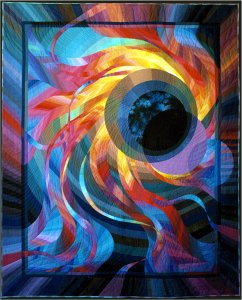
|
 |
 |
Design Concept
|
Since the time I was a young child in a grade school science
class, I have been fascinated by the dramatic storms on the
surface of the sun, which can flair out into the sky for thousands
of miles. The few minutes during a solar eclipse are the time
when astronomers are actually able to observe the solar storms
in the Corona of the sun.
This is my second quilt portraying the solar
eclipse (when the moon comes between the earth and the sun,
so that the disk of the sun is covered.) The Corona is the
envelope of ionized gasses, surrounding the chromasphere of
the sun, which is visible during a solar eclipse. CORONA II:
SOLAR ECLIPSE, is more a portrayal of my feelings about the
power of the sun, than an exact representation of what a scientist
might see through a telescope.
My use of a traditional quilt block on the
back of this contemporary art quilt is my tribute to the creativity
of the many anonymous quilt artists of the past. I chose "Robbing
Peter to Pay Paul" as my traditional block in this case,
because it is based on a circle, and carries out the circular
theme of the sun and moon on the front of the quilt.
Process
& Technical Details:
This quilt design began with a series of experiments with
overlapping transparent circles cut from colored plastic.
I drew a series of sketches, to see what I would like
the best. |
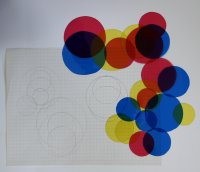 |
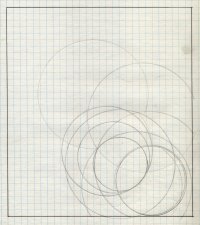 |
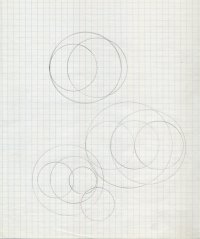 |
 |
| Once I decided how the circles would be
arranged, I experimented with the background and border
until I had a design I thought would work. (see below) |
|
|
 |
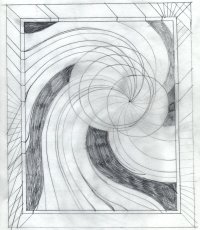 |
 |
|
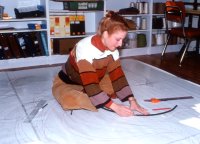 At
the time I did not yet own a computer, or an overhead projector,
so I taped together large sheets of paper and laid them on
the floor of my studio, which at that time was in the former
formal living room of our 1879 farmhouse in Oswego, Illinois.
and made a larger version of the pencil sketch. I used rulers
to draw perfectly square and parallel borders, and a yardstick
compass and flexible curve to draw a 76" x 94" version
of my thumbnail pencil sketch. At
the time I did not yet own a computer, or an overhead projector,
so I taped together large sheets of paper and laid them on
the floor of my studio, which at that time was in the former
formal living room of our 1879 farmhouse in Oswego, Illinois.
and made a larger version of the pencil sketch. I used rulers
to draw perfectly square and parallel borders, and a yardstick
compass and flexible curve to draw a 76" x 94" version
of my thumbnail pencil sketch.
When the large drawing was finished, I hung it on the wall
and began cutting it up to form my templates for piecing.
I began by piecing the circles of the sun and moon.
|
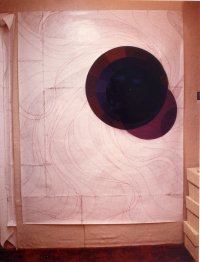 |
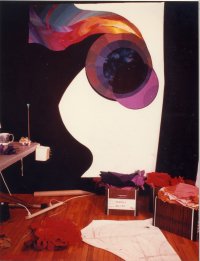 |
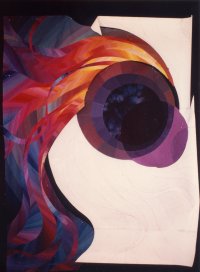 |
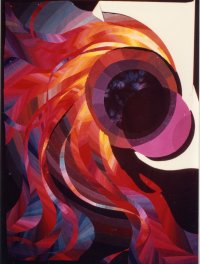 |
 |
The quilt is constructed from 100% cotton fabric, dyed, and
over-dyed in both chromatic (color to color) and value (light
to dark) gradations. These gradations create the illusion
of movement and light on the surface of the quilt.
Both the front and back of the quilt were constructed using
a traditional technique called string piecing. That
is, the picture was drawn full size on a piece of paper, and
then cut apart on the major lines of the design. Strips of
fabric in many different color gradations were sewn to these
paper templates.
|
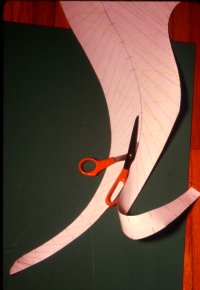 |
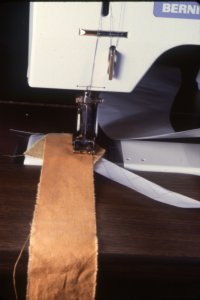 |
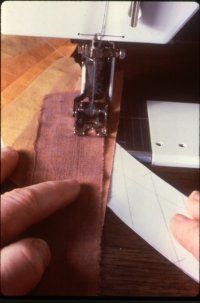 |
| Angle lines were drawn on the paper templates
as guides for the direction each strip would be sewn. Unlike
precision paper piecing, I did not sew on the line for most
of the templates. The sewing was done from the top, and the
lines were just the general direction of the next seam. Each
strip was at a slightly different angle, fanning out as they
went around the curves. The fabrics were arranged in gradations,
so there is not a dramatic difference in color or value from
one strip to the next, but on each long template the colors
start warmer and lighter and get darker and cooler as they get
closer to the outside edge of the quilt. This gradual progression
from light to dark and color to color created the luminosity
of the sun in the quilt. Notice that not all of the colors are
brilliant clear tones. Many are dull or even neutral. It takes
some smoke to make the brilliant colors glow. When I was arranging
the color gradations I pulled out lots of solid colored fabrics,
both hand-dyed gradations and commercial fabrics. |
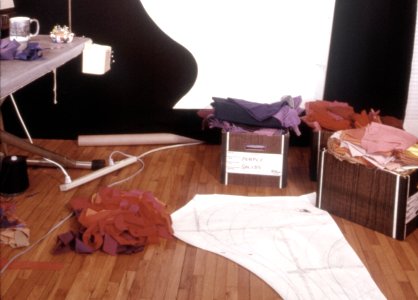 |
I cuts these fabrics into 1½" strips and
made piles on the floor of my studio (red, yellow, orange,
blue, purple). When I got ready to choose colors for
the next template I pulled fabrics from the piles and
arranged them in a gradation on my ironing board. No
two gradations in the quilt are the same. In some places
I have used a straight-out-of-the-dye-buckets hand-dyed
gradations, and in other places I have intentionally
put a warm red next to a cool red or a neutral of the
same value to create the spark needed to depict fire.
When the quilt top was complete, I still had lots of
fabric strips left in my piles so I used them to create
the giant (32") Robbing Peter to Pay Paul blocks
on the back of the quilt.
In the picture on the left you can see that I have
cut out a chunk of the big picture that I thought I
could manage to piece in a single day. It is lying on
the floor among my boxes and piles of solid colored
fabric. When that is finished it will be pinned back
into the rest of the design as it grows on the wall.
|
|

Here is the untrimmed
template lying paper side up. |
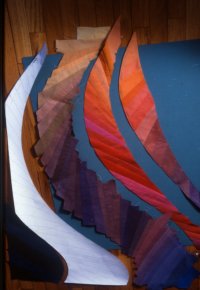
Here is the untrimmed template lying paper side
down. |

Here a line is being drawn around
the paper template with a soft pencil and the registration marks
are being transferred to the seam allowances. |
| After the templates were covered with fabric strips,
I drew a line around each paper template and transferred all
of the registration marks to the seam allowance with a white
pencil. The seam allowance was trimmed to a quarter inch from
the edge of the paper and then the paper was removed. In the
last picture below, the templates are trimmed and ready to be
sewn together. This was the last quilt in which
I sewed curved seams in the traditional way. After sewing this quilt together with seams from the back, I developed my hybrid "Applipiecing"
method, which has made joining curves much easier. Instructions
for Applipiecing are included in our FREE TUTORIAL about the making of Fossil Fantasy #1. |

The seam allowances
are trimmed to a quarter inch from the edge of the paper. |
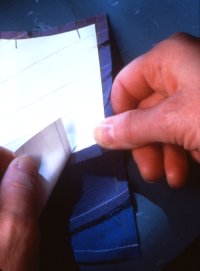
The paper is removed. |
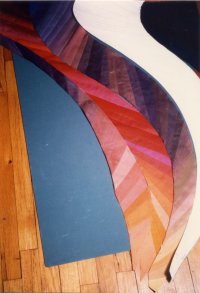 |
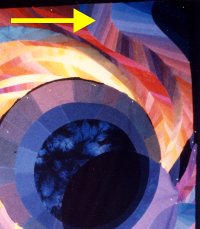
This is the template,
pinned back to the wall, after it has been joined to the adjacent
templates. |
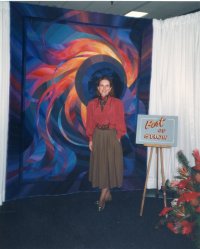
Caryl
standing with Best of Show Corona 2: Solar Eclipse, American
Quilters Society Show, April, 1989, Paducah KY
|
The American Quilters Society Show was the first exhibit
for Corona 2: Solar Eclipse, and it won the $10,000.00 Best
of Show purchase award and was donated to the National
Quilt Museum.

I was able to borrow it back three other exhibits outside
the museum which are listed below. Below is a picture of the
installation at the Dairy
Barn Southeastern Ohio Arts Center in 1990. It was displayed
along with Autumn
Aurora, a companion, wearable art ensemble created for
the Fairfield Fashion show later in 1989.
|
Publications:
- THE PADUCAH SUN - Thurs. April 20, 1989, THE PADUCAH
SUN Thurs. April 26, 1990 p. 25
- AMERICAN QUILTER magazine, Fall, 1989 FRONT & BACK
COVERS + article p.38
- AMERICAN QUILTERS SOCIETY, 1990 Wall Calendar - COVER
- ROUND BOBBIN, August, 1989, p. 4
- SEW BUSINESS, August, 1989, p.44
- QUILT JAPAN, Volume #14, 1990, p. 82
- STARDATE, Astronomy Magazine, May/June, 1990, p. 17
- AMERICAN QUILTERS SOCIETY, Show Poster, 1990
- LIBANA: FIRE WITHIN, 1990, COVER Art for Cassette, C.D.
and Songbook
- NEW WAVE QUILT: EXCELLENCE OF EXCELLENCES, Setsuko Segawa,
Mitsumura Suiko Shoin, p. 74
- QUILTS: The Permanent Collection, M.A.Q.S. Catalog,
1991 AQS, p19
- M.A.Q.S. Brochure 1991
- LOUISVILLE COURIER-JOURNAL, Magazine, Oct. 7, 1990 p.
8
- LEXINGTON HERALD LEADER, June 30, 1991
- AMERICANA magazine, Aug. 1991, p. 35
- AWARD WINNING QUILTS AND THEIR MAKERS, Volume II. AQS,
1992, p. 93
- CORONA II.: SOLAR ECLIPSE Jigsaw Puzzle, AQS, 1992
- BERNINA SEWING MACHINE AD, 1990-92, various magazines
- CBT CORPORATION, 1992 ANNUAL REPORT, pp.4-5 & inset,
1993 Paducah, KY
- CONTACT, May 13, 1993, p. 9 (New Zealand)
- MUSEUM OF THE AMERICAN QUILTERS SOCIETY CATALOG, 1994:
PP. 8 & 21
- IRIS: A Journal About Women, University of Virginia,
#32, Winter, 1994, COVER, pp12-14
- QUILTS IN ILLINOIS LIFE, 1995: Janis Tauer Wass, Illinois
State Museum, pp. 56 Feature Article
- CARYL BRYER FALLERT: A SPECTRUM OF QUILTS 1983-1995,
1996, AQS Books, pp. 38-41
- Windhover: A Journal of Christian Literature, Baylor
University Press, 2007, COVER & page 181
- Twentieth Century's Best American Quilts: Celebrating
100 Years of the Art of Quiltmaking, by Mary Leman Austin,
Primedia (Quilter's Newsletter Magazine and the International
Quilt Festival, along with Quiltmaker and McCall's Quilting
collaborated to determine the 100
best quilts of the twentieth century.)
- American Quilters Society 25th Anniversary Show Poster,
2009
- Fine Quilting & Fiber Art Guide: Paducah KY, 2013, Paducah Convention & Visitors Bureau, Paducah KY, p. 7
- Biodynamic Association of Northern California Newsletter, Summer, 2017 (COVER)
- Eclipse Viewing Glasses for August 21, 2017 eclipse over Paducah KY
- Paducah KY flood wall. First quilt panel behind Hilton Garden Inn • Installation: September, 2017
- AQS Catalogue of Show Quilts, 2019: Spring, p. 113, 114
- AQS Quilt Week Grand Rapids 2019 Show Book, p 35
- AQS Quilt Week Charleston 2019 Show Book, p 31
- Fiber Art Now, Vol. 9, Issue 1, Fall 2019, p. 26
- Exploring Art Quilts, Volume #3, SAQA, 2022. Schiffer Publishing, pp. 74&76 & COVER
- Crack the Color Code, 2025, MJ Kinman, p. 58
 |
Media:
Other: Flood Wall Mural, Paducah, Kentucky Convention Center, painted by Char Downs |
Exhibits
and Awards
- Corona #2: Solar Eclipse is usually on display at The
National Quilt Museum of the United States
- AMERICAN QUILTERS
SOCIETY SHOW, 1989, Paducah, KY (BEST
OF SHOW - $10,000.00 PURCHASE AWARD)
- BREAKING NEW GROUND, 1989, New
England Quilt Museum, (Juried) Lowell, MA
- THE QUILT MOVEMENT, (Invitational) 1990, The
Dairy Barn Cultural Arts Center, Athens, OH (VIEWERS
CHOICE)
- MUSEUM OF THE AMERICAN QUILTERS SOCIETY (National
Quilt Museum), 1991, Opening Exhibition, Paducah,
KY
- SPECTRUM: THE TEXTILE ART OF CARYL BRYER FALLERT, Solo
Exhibition, 1996 Museum of the American Quilters Society
(National
Quilt Museum), Paducah, KY
- Hundred
Best Quilts of the 20th Century, International Quilt
Festival, Houston TX, 2000
- Caryl Bryer Fallert: A Retrospective, New England Quilt Museum, Lowell, MA, August 20 - October 31, 2015
- Caryl Bryer Fallert-Gentry: 40 Years of Color, Light, & Motion, Mitchell Museum, Cedarhurst Center for the Arts, Mt. Vernon, IL, July 31-October 9, 2016
- 35 Years of AQS: Anniversary Showcase Preview, AQS Quilt Week
- Grand Rapids, MI, August 21-14, 2019,
- Charleston , SC, September 25-27, 2019
- A Life in Color: 50-year Retrospective Solo Exhibition, National Quilt Museum, Paducah, KY, March 14-October 7, 2025
|
|
Web Site Design by Caryl Bryer Fallert-Gentry © 1997-2025
All Rights Reserved
Bryerpatch Studio • 10 Baycliff Place • Port Townsend, WA • 98368 • USA
360-385-2568 • caryl@bryerpatch.com
•••••
Updated
12/29/2025
|

